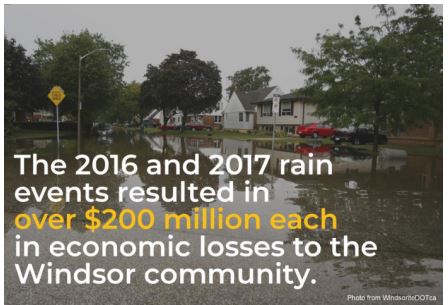
In recent history, IBC has reported two catastrophic losses for the Windsor Community. Extreme precipitation events in 2016 and 2017 leading to massive flooding reported insured losses of $108 million and $124 million, respectively. Based on the results of a Partners for Action survey completed after the flooding events, approximately 44% of Windsorites paid for flooding damages through insurance and only 0.5% received government disaster assistance. The rest of the homeowners who had flooded self financed their restoration through personal savings, loans, RRSPs or other means. Therefore, it is assumed that both the 2016 and 2017 rain events actually resulted in well over $200 million each in economic losses to the Windsor community. It is important to note that this does not factor in costs such as lost wages, loss of irreplaceable items, as well as emotional and physical toll on homeowners during and after flood recovery.

Public Safety Canada estimates that for every dollar invested in climate change adaptation $3 to $5 is saved in recovery costs (Auditor General, 2016). Similarly, an independent study commissioned by the U.S. Federal Emergency Management Agency found that the return on investment in the United States was $4 in cost savings for every $1 spent on disaster mitigation (adaptation). Studies in Australia have found a return of 3:1, while in the United Kingdom, 5:1 (Ontario, 2019).
For more information, refer to the Climate Change Impacts in Windsor – A Technical Analysis document which includes further estimates of the “cost of doing nothing” for each identified impact, where enough data was available.